The phases of the Moon throughout the human life, or why “New Year’s resolutions” is a bad idea
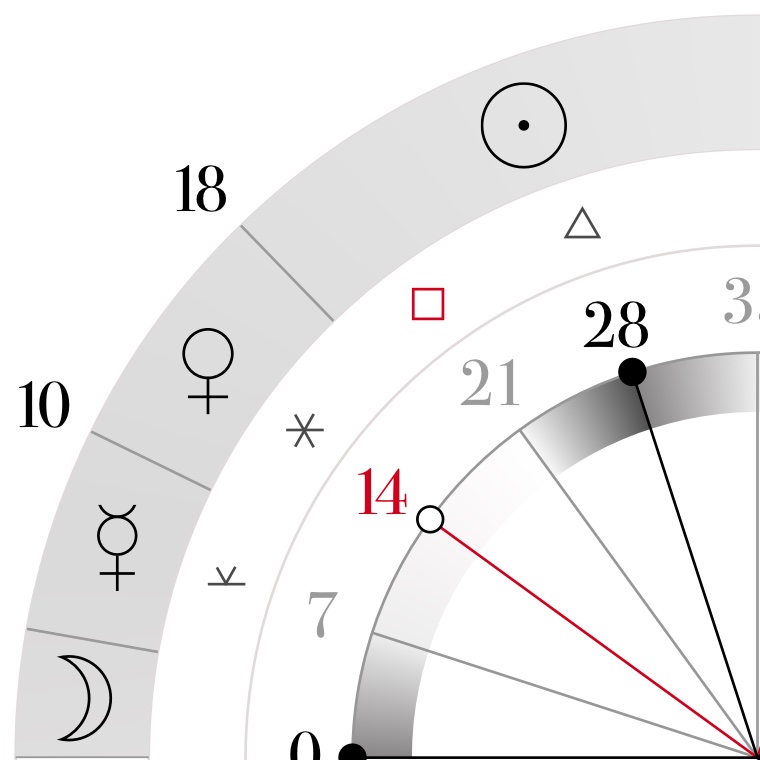
The low efficiency of the New Year’s resolutions approach is due to the resolutions often being a mental construct that ignores the bigger dynamical system that is called “your life”.
A simple answer to the second question as to why “New Year’s resolutions” is a bad idea — “improving” the year ahead rarely works because that single year is taken out of the bigger context of the unfoldment of life. Infamous low efficiency of the New Year’s resolutions approach is due to the resolutions often being a mental construct that ignores the bigger dynamical system that is called “your life”.
Seeing your life as an unfoldment of phases squarely puts your choices and actions in the context of planetary forces and cosmic principles that are acting at the current moment. It’s like surfing an ocean wave: no matter what we imagine, we can’t really surf until there is a real wave moving in the right direction.
The phases of the Moon and their influence on human life
Apart from influencing periods of the lunar month, the phases of the Moon — or rather the principles behind the phases of the Moon — also shape the periods of human life that span across years and influence our subconscious interaction with the world around us.
There are numerous ways to divide the duration of human life into meaningful periods that make sense from the astrological standpoint. One of the methods called “planetary periods” has been looked at in the previous story “The Seven Ages of man”.
The current story will look into how the principles behind the phases of the Moon apply themselves to whole periods of human life. As an extra, we will also add Uranus, a rather surprising addition to the Moon’s phases. The story will culminate with a printable map of life that helps with seeing a bigger picture — your bigger picture.
“Threescore and ten” — remembering the old times
The days of our years are threescore years and ten;
and if by reason of strength they be fourscore years,
yet is their strength labor and sorrow;
for it is soon cut off, and we fly away.Psalms 90
Remembering that “score” is an old style word for “twenty”, the Bible traditionally averages our life span to 3 × 20 + 10 = 70 years, and for those who are lucky is “fourscore” meaning 4 × 20 = 80 years, which is rather precise given the average span of modern life is 79 years as of the year of 2019.
And of course, the immortal Shakespeare’s words:
Threescore and ten I can remember well…
William Shakespeare, Macbeth
From historical and statistical perspectives, a 70-year life span is certainly closer to the average. And it’s a nice number since it includes the magical number 7. Here is a refresher as to why the number seven is so interesting.
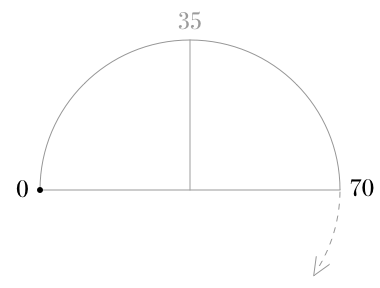
Suppose we decided to use 70 years of human life and draw it as a half circle, or an arc of 180º. The zero on the left marks the moment of birth, the number 35 marks the middle of life and the 70th year mark is positioned at 180 degrees. The life doesn’t stop at 70, it keeps going.
The Moon phases and a progressed chart
A progressed chart is a “preview” of how native’s life could unfold through the years to come. The idea behind the astrological technique of progressed chart also comes from the Bible, that says:
I have appointed thee each day for a year.
Ezekiel 4:6
The progressed chart technique called “primary directions” looks at the astrological charts of the first days of life. Time Nomad app makes it easy to work with progressed charts.
Back to the Moon…
Knowing that the phases of the Moon occur approximately every seventh day, and using the progressed chart idea of a “day-for-a-year”, one can intuit that the whole span of human life can be presented as a sequence of the phases of the Moon:
- the New Moon marks the beginning of life
- the First Quarter marks the 7th year
- the Full Moon marks the 14th year
- the Last Quarter marks the the 21 year
- then the next Moon cycle starts at the 28th year
- and so on as illustrated below…
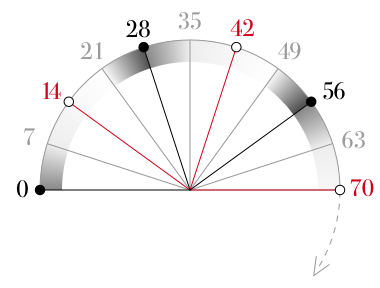
The illustration shows that:
- years 0, 28 and 56 correspond to the New Moon phase and thus mark the beginning of a cycle that will last for next 28 years
- years 7, 35 and 63 begin a period of development
- years 14, 42 and 70 mark the culmination of the effort
- years 21 and 49 each begin a seven year phase of “reaping the harvest” that has been worked on
This makes sense. For example, a child starts studying at around 7 years old, at 14 years old the child is reaching full intensity of their school years, culminating at around the 21-24 year when full education cycle has been completed and the young professional is ready for working life.
The second period of professional maturation, career building or establishing a family takes place during years 28 – 42 and the “reaping of the harvest” phase starts at about 51 year of age.
The third phase begins at about 58 year mark. It comes with the idea of a free choice of what and how to spend it. The duties have been hopefully done and the native is free to follow the calling of their heart in whatever form it comes.
Uranus as an agent for change
Movement of Uranus coincides with the changes of the phases of the Moon at the scale of human life.
Orbital period of Uranus is 84 years (to be precise, the orbital period of Uranus is 84.0205 years or 30,688.5 days), meaning that Uranus covers one sign of the Zodiac every 7 years.
Every 7th year transiting Uranus makes the following aspect to the natal Uranus:
| Year | Angle | Aspect |
|---|---|---|
| 7 | 30º | Semisextile |
| 14 | 60º | Sextile |
| 21 | 90º | Square |
| 28 | 120º | Trine |
| 35 | 150º | Inconjunction |
| 42 | 180º | Opposition |
| 51 | 150º | Inconjunction |
| 58 | 120º | Trine |
| 63 | 90º | Square |
| 70 | 60º | Sextile |
| 77 | 30º | Semisextile |
| 84 | 0º | Conjunction |
Uranus is an agent for change and the words “sudden” and “surprise” describe it really well. By coinciding with the phases of the Moon, Uranus brings about required push to ensure that the person moves along their time line. Uranus can come with an electric kind of shock and even challenge health. Those Uranian transits are something to be aware of and keeping one’s life moving certainly helps to minimise Uranian kicks in the soft place.
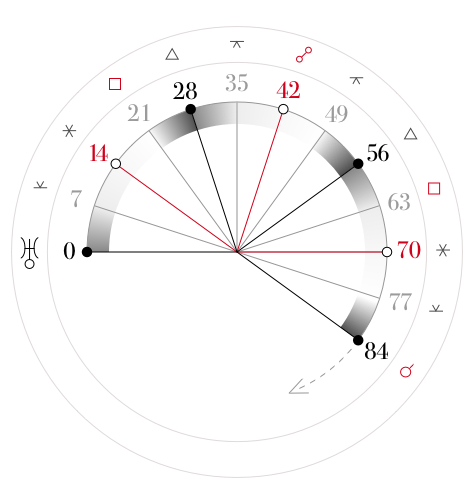
The illustration above adds Uranian transits to the phases of the Moon mapped along the average span of a human life. And since we’re living in the 21st century, let’s extend the average life expectancy to 84 years!
The addition of the Uranian transits makes a few important years stand out:
The 21st year of life
Uranus square coincides with the last quarter of the moon. This calls for the action of incarnation supported by the phase of “reaping the harvest” of previous years devoted to studying the world.
The 42nd year of life
Uranus opposition brings polarity that arrives at the fullest of the Moon. The high tension of the full Moon reinforced by the Uranian polarity makes a loud call to action.
The 63rd year of life
Transiting Uranus is square to natal for the second time, it starts the next phase of life this time expressed through the energies of the first quarter of the Moon with its symbolism of organic development and revitalisation. Those are the years of reinventing the life style and setting longer terms goals based on the learnings acquired in previous decades — 63 is the new 7 but with more wisdom and practical skills.
What about the planetary spheres?
For the sake of a more complete picture, we can add one more layer of planetary spheres that was discussed in the previous story, “The Seven Ages of man”
Thus the course of human life can be viewed as combination of the three layers of cosmic principles (that’s not to say there are no other principles, there are certainly many more of them):
| Principle | Influences |
|---|---|
| The planetary spheres | Personal values as expression of planetary qualities |
| The phases of the Moon | Supplier of energy, quality of energy |
| Transits of Uranus | Driver for change |
The diagram below attempts to create a lookup guide at the development of one’s life through years and cycles.
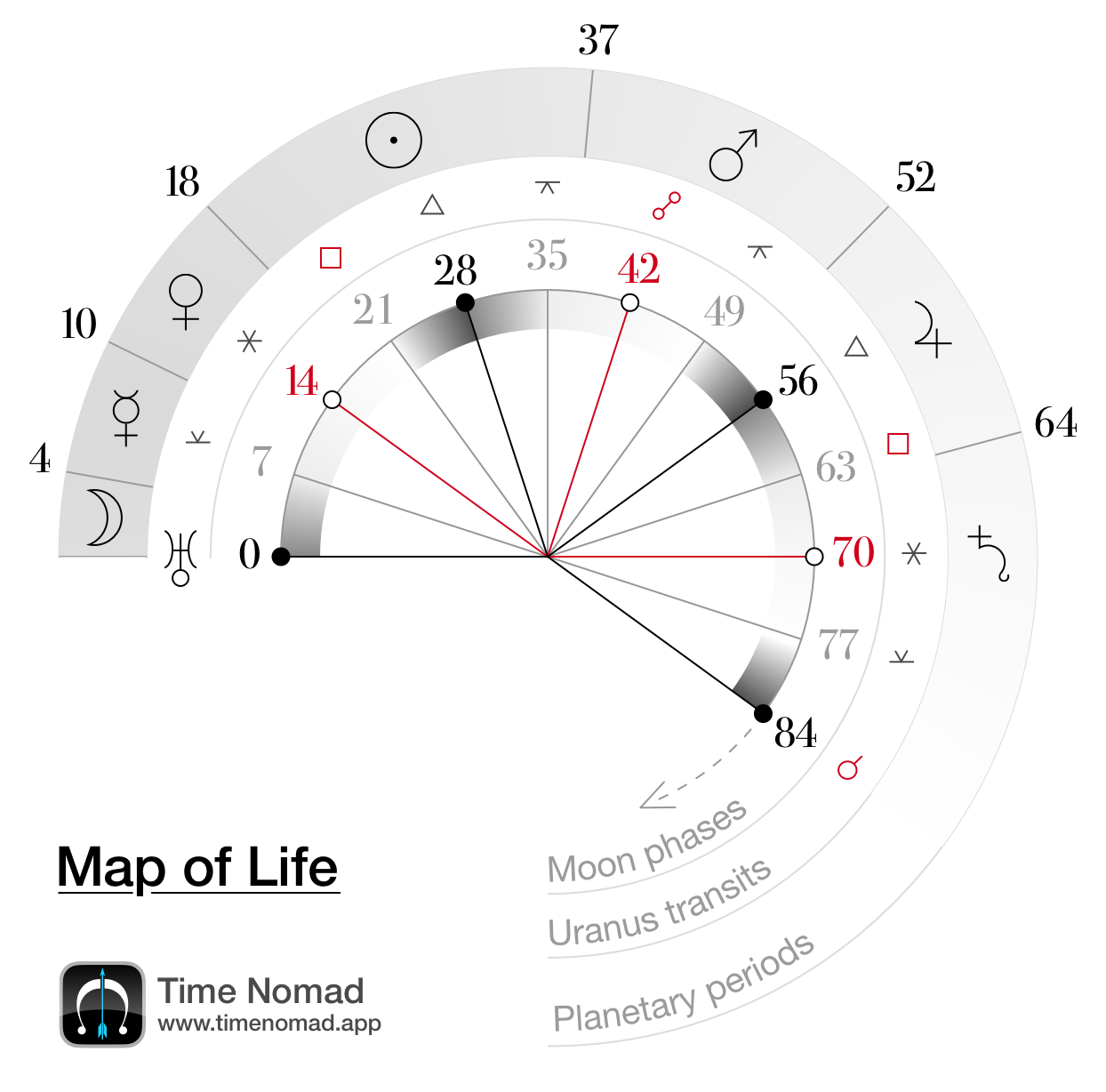
In its entirety, the “Map of Life” diagram may look somewhat intimidating. We hope that this story allows for an easier understanding how so many principles work together towards forming a bigger picture. The reader is welcome to print it and pin it to the wall. The map will help to see where you are and how your life is unfolding in the context of the whole life, thus escaping the uninspiring chores of the New Year’s resolutions.
What about Saturn returns?
We consciously excluded Saturn returns not to overcomplicate an already complex picture. Saturn returns take place at approximate ages of 27–31, 56–60 and 84–90 with the exact year depending on each individual chart.
Seeing life as a dynamic system
Many clients of astrology ask a typical question of “when this or that will happen to me?” Instead of coming up with numbers and predictions, an experienced astrologer strives to see the unfoldment of one’s life as a dynamic flow of ebbs, tides and personal choices and resulting actions. Life events don’t pop out of blue simply because numbers say so, meaningful life events are consequences of actions taken in prior years.